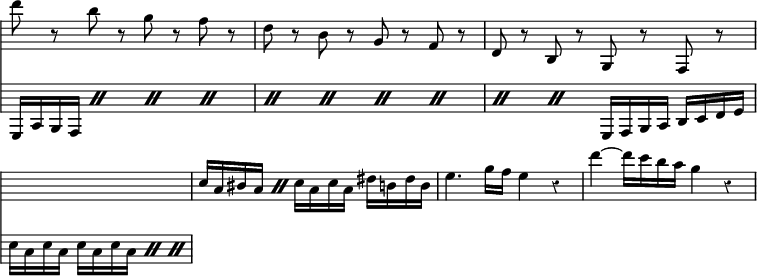contains some extremely valuable sketched memoranda, made during the progress of the Music for 'The Ruins of Athens,' 'Adelaida,' the little Sonata in G minor (Op. 49, No. 1), and numerous other works, including a complete copy of the 'Sonatina per il Mandolino' already printed at p. 205 of our second volume. More interesting still are some of the Sketch-books in the Royal Library at Berlin. From one of these, written between the years 1802–4, and carefully analysed by Nottebohm,[1] we extract a series of records connected with the Sonata in C major, Op. 53, dedicated to Count Waldstein—a work so generally known, that our readers can scarcely fail to take an interest in the history of its birth, infancy, and development to maturity. The first Sketch, at page 120, dashes into the Subject of the opening Allegro, by aid of a few prefatorial bars which go far to induce our belief in some still earlier memorandum.

At page 122 follows the first idea of the Modulation which introduces the Second Subject.

The Second Subject itself first appears at p. 123, in G; and in a form far inferior to that in which it makes its first entrance, in E, in the finished Sonata.

The close of the First Part is suggested on p. 122.

On p. 123 we find a Sketch for the opening of the Second Part—

and, on p. 131, the close of the Movement.

Alternating with these memoranda, the volume presents some intensely interesting Sketches for an Andante, the first suggestion for which appears at p. 121, in E major.
![{ << \new Staff \relative g' { \key e \major \tempo "Andante." \time 3/8 \override Score.TimeSignature #'stencil = ##f \partial 8
gis16. a32 | fis8[ b] e,16. fis32 | dis8[ gis] cis,16. dis32 |
e8. fis16 gis a | gis8 fis }
\new Staff \relative e' { \key e \major \clef bass
e8 | dis[ b] cis | b[ gis] a | gis8.[ dis16 e a,] | b8 b' } >> }](http://upload.wikimedia.org/score/3/k/3kd6opc8a9qt4sobjxu8iww49ncamnx/3kd6opc8.png)
Immediately afterwards, this first idea reappears, in a modified form, and in combination with a phrase justly dear to all of us.
![{ << \new Staff \relative b' { \key e \major \time 3/8 \override Score.TimeSignature #'stencil = ##f \override Staff.Clef #'stencil = ##f \partial 8
b32( gis) b( gis) | a8[ fis] fis'32 dis fis dis |
e8[ b] b16. cis32 | b8[ a16 gis fis gis] | gis8[ a] a16. b32 }
\new Staff \relative g { \clef bass \key e \major \once \override Staff.Clef #'stencil = ##f
gis32 e gis e | fis8[ dis] \clef treble a''32 fis a fis |
gis8 e s | s4. s } >> }](http://upload.wikimedia.org/score/t/r/trp9t9l9sjq55pbwmmn4nzmiryrwt5c/trp9t9l9.png)
- ↑ 'Ein Skizzenbuch von Beethoven aus dem Jahre 1803.' etc. B. & H. 1880. This was preceded by an earlier one, containing the 2nd Symphony and other works, and published in 1865.

